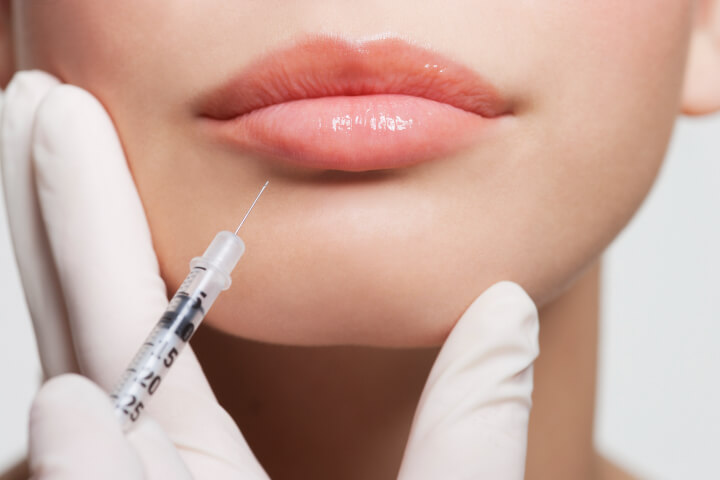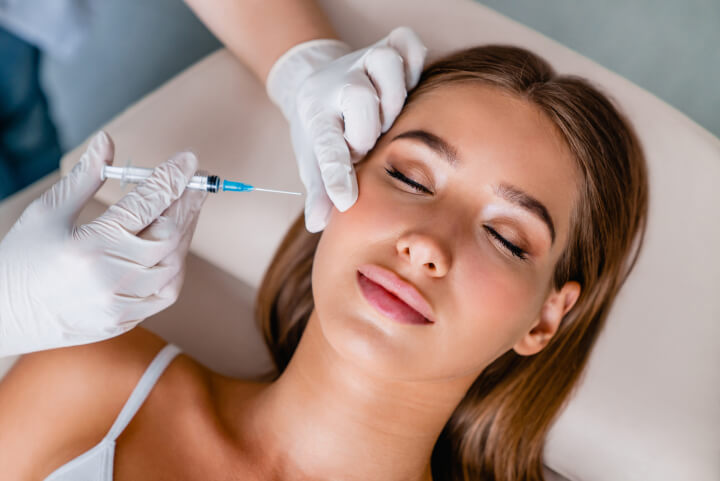
People are only young once and as you get old, it’s a fact that your face and skin will show inevitable signs of aging. But for anyone who wants to appear youthful than their years, Botox is one of the best cosmetic investments that they can make. This cosmetic injectable treatment works as a muscle relaxant to keep new wrinkles from forming and smooth away facial folds and creases on almost any part of the face.
But which muscles do you target for lower lip corner creases using Botox? Botox is injected into the depressor anguli ori, the facial muscle that is part of the lower jaw and is responsible for pulling down the corners of your lower face area. This treatment is called a Botox mouth lift, which is a cosmetic procedure intended to fix the droopy corners of the mouth and erase the wrinkles around your lower lip.
Aesthetica can assist you with all your beauty needs, helping you achieve your maximum beauty and aesthetic potential. Call or contact us today to learn more about our cosmetic services.
Botox or botulinum toxin is a popular cosmetic solution for many people who want to achieve facial rejuvenation without plastic surgery. It’s essentially a neurotoxin injection with muscle relaxing properties and it corrects lower lip corner creases and lip wrinkles by weakening the muscles responsible for their facial movement.
To better understand, Botox cosmetic injections contain the purified protein form of the Clostridium botulinum bacteria. When used in cosmetic medicine, a botulinum toxin injection can block facial nerve endings to stop the release of chemicals that activate muscle contraction. With limited activity in the facial muscles, the appearance of wrinkles and fine lines will be improved and it will prevent new ones from forming.
Experienced Botox injectors know that the key to successful injections is having a good understanding of the facial anatomy. It’s crucial that the Botox injections are placed accurately to the intended muscle groups to get the best treatment outcomes. Now in aesthetics, the face can be divided into three distinct parts: upper third, middle third, and lower third of the face. Plastic surgeons use this as a guide in performing Botox treatment.
When treating lower lip and mouth corner creases with Botox, cosmetic surgeons look into the lower third area of the face. This lower third of the face comprises some of the most prominent features that make up a person’s profile and physical appearance. This includes the lips, jawline structure, and chin.
The Botox mouth lift procedure for corner creases is performed by inserting the injections to the depressor anguli oris muscle. This particular facial muscle is located near the jaw or mandible and extends to the corners of the mouth. Its primary function is to move and pull down the mouth when a person does certain expressions such as frowning.
Combining years of muscle movement with loss of skin elasticity over time, the depressor anguli oris gets overstretched which can exaggerate the droopiness of the lower lip and mouth corners. Vertical lip lines and upper lip wrinkles can also be corrected with Botox injections. It works by targeting the orbicularis oris muscle which is connected with other muscles in the lower third region and stimulates actions such as speech and lip puckering.
Injecting Botox into these particular muscles can freeze their movement and gradually allow them to elevate the corner mouth and lip areas to improve your frowning appearance or enhance facial asymmetry. It can also soften the vertical lines that show on your upper lip and lower lip, and can be used for lip augmentation to achieve a fuller lip look.
Lower lip lines and corner creases around the mouth can be caused by different factors but the very obvious one is natural aging. The facial contours and texture of your skin naturally change as it loses collagen and elastin. These two are important building blocks that make up the skin’s healthy, firm, and elastic texture.
But as you get old, the production of collagen and elastin declines and your skin begins to diminish in quality. The lips are a particularly delicate area and it normally becomes thin with old age. In addition, the mouth is involved in many facial reactions and movements that it becomes more prone to sagging and drooping over time.
Loss of facial fat and volume can also influence the formation of facial creases around the lower lip and mouth area. Fat is evenly distributed in your younger years but it naturally gets stored in hard-to-reach fat deposits and results in thinning of lips and wrinkling of skin along the edges of your mouth. Some fat can be redistributed to the lower jaw which leads to the appearance of jowls and loose neck skin.
Certain lifestyle factors can also result in lines and creases on the lips and around the corners of the mouth. Excess sun exposure can accelerate the decrease of collagen production and result in premature skin aging. The loss of collagen will naturally make mouth lines and lip wrinkles more noticeable and make you look older than your age.
Frequent smokers also have high chances of developing lines and creases on their lower lip in their early years. This is because smoking can increase the damage to your collagen production in the skin by depleting fibroblast cells. This will speed up the aging process and cause the skin on your lips and around the mouth to shrivel up and look more wrinkled. Smoker’s lines are often visible on both sides of your lips and can run from the mouth towards the nose.
Botox is a minimally invasive and straightforward procedure for correcting lower lip corner creases and mouth lines. It’s truly a revolutionary cosmetic treatment since it’s completely non-surgical and only requires a few injections of the botulinum toxin to the targeted facial muscle groups.
The Botox experience will begin with an initial skin consultation with your provider or cosmetic doctor. They will assess your skin condition and the severity of your wrinkle condition to create an individualized treatment plan.
On the day of your Botox treatment session, your provider will prep the injection syringe and needles for the procedure. They will use very small needles to penetrate the skin and deliver the toxin to the muscles so there is minimal pain felt during the treatment. If you have a low or moderate tolerance for pain, your physician can apply a topical anesthetic on the injection site to minimize the piercing sensation of the needles.
Your provider can inject around 2 to 4 Botox units to treat the downturned corners and creases around your lower lip and mouth. Botox injections are placed on each side of the mouth to lift the skin and soften the appearance of lines and wrinkles. In addition to mouth lift, placing the Botox on these areas reduces the visible marionette lines and nasolabial folds and improves the shape of your mouth.
An average of 4 to 8 Botox units can also be injected for treatment of vertical lip lines or Smoker lines. For this procedure, the injection sites are located on the orbicularis oris muscle and it will effectively erase the lines on both the upper lip and lower lip.
The entire Botox treatment is quick and convenient and can only take 15 to 20 minutes in the cosmetic surgeon’s office. Most Botox patients can go back to their normal activities after getting the injections. Compared to cosmetic surgery, Botox recovery doesn’t need any downtime or rest period.
You can experience several side effects but they’re mostly manageable and they will go away within a few days. Some of the common side effects of Botox injections are injection site pain, minimal swelling, bruising, tenderness, redness, and numbness. Applying a cold compress or ice pack can generally help to remedy the discomfort from post-Botox reactions.
Adverse effects and serious reactions from Botox lip injections rarely occur as long as you receive the treatment from an experienced practitioner. They may happen only due to poor Botox injection techniques, misplacement of the injection to the wrong muscles, or unintended migration of the neurotoxin to other areas of the face.
Botox results on your lower lip wrinkles and mouth creases can be visible in at least 10 to 14 days following the treatment. The reason why its effects are not immediate is that it takes time for the toxin to completely block the action of the chemicals in the facial muscles. Once it takes full effect, you can enjoy Botox improvements for 3 to 4 months.
Learn More: How Long Does Swelling Last After Lip Botox Injections?
Botox is known to be an effective prescription medicine for relieving symptoms of medical conditions like chronic migraine, excessive sweating or hyperhidrosis, overactive bladder, neck spasms, and cervical dystonia. And in the aesthetics sense, Botox has many uses aside from the treatment of the lower face for lower lip creases and lines.
The upper region of the face is where horizontal forehead lines, Crow’s feet, frown lines, and glabellar lines are usually seen. Eyelid droop and drooping eyebrows are also prominent in this area of the face. This part of the face can be further divided into three muscle groups: the forehead, glabella, and periocular (around the eye).
The middle area of the face pertains to the lower corners of the eyes and runs down to the area just above the upper lip and mouth. This includes the nose, cheeks, and region on your upper mouth and lip.
For the lower face area, Botox can also be used to improve the appearance of chin dimpling or creases and contour the jawline profile. Injections to the mentalis muscle can rejuvenate and soften the wrinkles on the lower chin. Meanwhile, Botox injections in the masseter muscle which connect the cheekbone and jaw muscles can help slim your profile and make your lower face appear more defined.
Learn More: Which Muscles Are Injected With Botox for Lower Lip Corner Creases?
Botox and dermal filler are both effective cosmetic injectables for facial wrinkles and lines. The main difference is the Botox stops muscle activity to correct and prevent dynamic wrinkles while a lip filler injection uses gel material (usually made of hyaluronic acid) to restore volume and fill in the severe creases and deep lines. Some of the popular injectable filler products are Restylane Lyft, Restylane Refyne, and Juvederm filler.
In some cases, your cosmetic doctor may suggest getting both Botox injections and dermal filler treatment for complete facial rejuvenation. Botox will help smooth out the wrinkles and lines while a facial filler will bring back volume and fullness and subtly lift the face for a more youthful appearance.
Learn More: Can You Get Botox and Dermal Fillers Under the Eyes and Lips at the Same Time?

Leave your wrinkle problems and skin concerns to the hands of expert Botox injectors at Aesthetica. Our team of certified cosmetic practitioners and highly trained staff ensure safe and effective Botox treatments to give you the best results you can get.
At Aesthetica, we take anti-aging treatments and cosmetic procedures to the next level with our quality products and services. We believe that every individual has unique needs so we make sure that every treatment is tailor-fitted based on our doctor’s careful assessment of your proportions and skin type. Start your Botox journey with us and contact us to schedule your consultation with one of our specialists today.
Aesthetica can assist you with all your beauty needs, helping you achieve your maximum beauty and aesthetic potential. Call or contact us today to learn more about our cosmetic services.